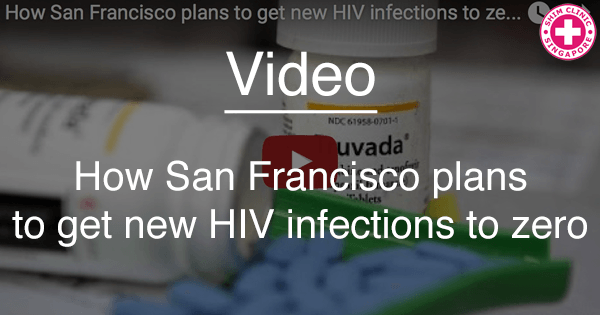This video investigates San Francisco’s plan to reduce the number of new HIV infections to zero. NewsHour’s John Carlos Frey talks to doctors, social workers and patients to understand the work they are putting into making the getting to zero program successful.
The report introduces Ward 86, an outpatient HIV clinic at San Francisco General Hospital. There they follow a protocol called RAPID to provide immediate treatment to newly diagnosed patients. At Ward 86, nurse and doctors work closely to devise a specialised treatment plan for each patient.
Frey points out that 50,000 new infections take place every year in the US. About 13,700 people still die each year, even though drugs and treatment regimes have made infection manageable. It is still the 6th leading cause of death in the world. In San Francisco particularly, 302 new infections were recorded in 2014, which mainly comprised of gay men. Even though these numbers have been reducing for the last years, they are still significantly high. Thus the getting to zero program was introduced in San Francisco.
Dr. Diane Havlir, Chief of HIV/AIDS Division at San Francisco General Hospital, is also a pioneer of the getting to zero program. She says that HIV is one of the worst epidemics to have hit the city as well as the world. Treatment and prevention, both have been out there for a while, thus she says, its high time to prevent each and every case of HIV. Frey also talks to a patient of Dr. Havlir and shares his story from being diagnosed to becoming one of the virally-suppressed people. The patient underwent the RAPID treatment and within 30 days, the viral level was undetectable in his blood stream. This means that the viral load reduced to a level at which it was not detectable anymore. The faster this transition is made, the lower the chance of the transmission of the virus. Although well established prevention techniques and novel drugs are important, another critical aspect is the immediate availability of treatment for new infections. The city has a large proportion of HIV infected people, who are virally suppressed. The numbers are much more than the US Average.
Frey follows a social worker, Torres, who put up a lot of effort ensuring that infected people could get to the treatments. She tracks people down and reminds them of appointments, treatments and consultation.
Another path that the getting to zero program has followed is the path of Truvada®. It is a preventive drug, also used for HIV post-exposure prophylaxis (PEP) or HIV pre-exposure prophylaxis (PrEP), which can reduce the risk of getting infected by HIV by 90%. It is recommended for people with a high risk to exposure to HIV, the exposure could be occupational or professional. The dosage of the drug is crucial. It has to be taken regularly every day. Scott Wiener, an elected city supervisor and a member of the getting to zero team, made his Truvada regimen public last fall to raise awareness about it among people. He is also a representative of the gay community of San Francisco. So he also took this step to reduce stigma and inspire more people.
Truvada is surrounded by a plethora of controversies and stigmas. Frey discusses the opinion that Truvada offers a free pass and promotes not using condoms. It is also said to possibly promote more promiscuous behaviour, even though it is FDA approved. CDC issued guidelines for its use last year. A study published in September states that users of Truvada were free of HIV contraction in a period of 2 years. However the use of the drug is still not very wide spread. The main reasons behind this are that they have some side effects which makes doctors hesitant to recommend it to healthy individuals. In addition, there is the financial aspect. The monthly costs of taking Truvada sums up to more than 1000 dollars per month.
Michael Weinstein, the president of the AIDS Healthcare foundation, says that Truvada is ‘not a good public health strategy’. He says that not following the regime strictly and missing daily doses makes the efficacy of the drug go down. In addition, people use it as an alternative to using other safe sex measures like condoms. This leads to them contracting other STDs and STIs. Kaiser Permanente’s study showed that although none of the Truvada users contracted HIV, there was a reduction by 41% in condom use and after 1 year 50% of the users contracted another STD.
Barabara Garcia, The San Francisco Department of Public Health Chief, is working towards ensuring that the drug is taken as prescribed and other safe sex practices ,which include HIV testing and STD testing, are not being ignored. She claims that this can be achieved by educating young people. The city has encountered a rise in other STDs, but it isn’t necessarily related to the use of Truvada.
She strongly believes in the getting to zero plan. She says HIV prevention is much more efficient, both financially as well as socially, than having HIV positive populations to care for.
The video concludes by a discussion with Dr. Havlir, during which she says that the getting to zero program is doing well. It is a difficult goal, but achievable. Mayor Edwin M. Lee announced annual funds worth of 1.2 million for this program. This funding will be used for testing new drugs quickly and also for making them easily accessible to HIV positive patients.

